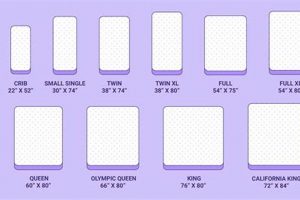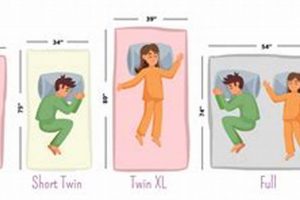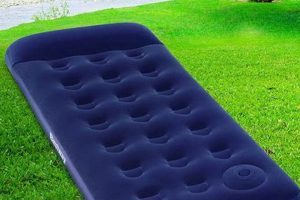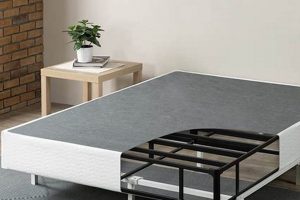A bed dimension, smaller in length than a standard queen, provides a solution for rooms where space is a premium. This particular mattress type offers a width identical to a standard queen while reducing the overall length, generally by a few inches. For example, a traditional queen mattress measures 60 inches wide by 80 inches long, whereas the reduced-length version maintains the 60-inch width but shortens the length to around 75 inches.
The reduced footprint is highly beneficial in smaller bedrooms, RVs, or guest rooms where a full-sized queen would overwhelm the space. The shorter length allows for easier maneuverability around the room and the possibility of incorporating other furniture. Historically, custom mattresses were the only avenue for achieving this dimension; however, certain manufacturers now offer this size as a standard option. The benefit allows people of average height to have a queen size bed with a shorter version for a suitable solution.
Having established a foundational understanding of the size and its advantages, the following sections will delve into specific scenarios where it proves particularly useful, compare it against other mattress sizes, and explore factors to consider when purchasing one, including available bedding and frame options.
Considerations for Selecting a Reduced-Length Queen Mattress
Choosing a bed of this dimension requires careful consideration to ensure optimal comfort and space utilization. The following points outline important factors to evaluate prior to purchase.
Tip 1: Measure the Available Space: Accurately measure the room’s dimensions to confirm sufficient clearance around the bed. Consider door swings, walkway space, and other furniture placement to prevent overcrowding. Ensure that the reduced length provides a tangible improvement in spatial efficiency.
Tip 2: Assess Occupant Height: While a shorter length benefits room layout, it’s crucial to assess the height of the individual(s) sleeping on the mattress. Taller individuals may find the reduced length constricting, potentially impacting sleep quality and comfort. A trial period, if available, is recommended.
Tip 3: Confirm Bedding Availability: Standard queen-size sheets are often too long for reduced-length queen mattresses. Before purchasing, verify the availability of properly sized bedding. Custom-made sheets may be required, impacting overall cost.
Tip 4: Research Frame Options: Not all bed frames are compatible with these mattresses. Investigate frame availability and ensure the chosen frame provides adequate support. Adjustable bed frames may have limited compatibility.
Tip 5: Evaluate Mattress Firmness: Mattress firmness is independent of size. Evaluate personal preferences for firmness level, considering factors such as sleeping position and potential back problems. Firmness levels range from plush to extra-firm.
Tip 6: Compare Mattress Types: Different mattress types, such as memory foam, innerspring, or hybrid, provide varying degrees of support and comfort. Compare the features of each type with a size that fits.
These considerations are essential for making an informed decision about purchasing this type of mattress. Prioritizing room dimensions, occupant height, bedding compatibility, frame options, and personal preferences ensures a comfortable and functional sleep environment.
Having addressed these vital considerations, the subsequent sections will provide specific scenarios where a reduced-length queen mattress proves most advantageous and offer comparisons with other common mattress sizes.
1. Spatial Efficiency
The primary impetus for selecting a queen short mattress is spatial efficiency, a direct response to the dimensional constraints of smaller rooms. The causal relationship is evident: limited floor space necessitates the reduction of bed length to preserve room functionality. The importance of spatial efficiency as a defining characteristic of this mattress configuration cannot be overstated. Its core purpose is to provide the sleeping surface area of a standard queen while minimizing the overall footprint. For example, in an urban apartment with a bedroom measuring 10 feet by 12 feet, a standard queen mattress might impede circulation and limit furniture placement. A shorter queen allows for unobstructed walkways and the inclusion of essential pieces, such as a dresser or desk. The practical significance of understanding this relationship lies in the ability to optimize living spaces, maximizing utility without sacrificing sleep comfort.
Further illustrating the point, consider recreational vehicles (RVs). Space within an RV is at a premium, often requiring creative solutions for sleeping arrangements. A short mattress allows for a larger bed than would otherwise be possible, increasing comfort during travel. Similarly, small guest rooms in residential homes often struggle to accommodate a standard queen bed comfortably. The reduced-length version makes it feasible to offer guests a more spacious sleeping area without compromising the room’s overall usability. The selection of appropriate size increases the versatility of the room.
In summary, spatial efficiency is inextricably linked to the very definition and application of a queen short mattress. By reducing the overall length, it provides a targeted solution for environments where floor space is limited. Understanding this correlation allows individuals to make informed decisions about mattress selection, aligning comfort with the pragmatic demands of their living quarters. Overcoming the challenges of small spaces is a focus.
2. Height Accommodation
Height accommodation represents a critical consideration when evaluating a queen short mattress. The reduced length, a defining characteristic, directly impacts the suitability for individuals of varying statures. A potential mismatch between sleeper height and mattress length can result in compromised sleep quality, manifesting as discomfort or restricted movement. Selecting the appropriate mattress dimension necessitates a thorough assessment of individual height to ensure adequate body support and freedom of movement during sleep. Failing to consider this aspect can lead to practical difficulties, such as feet extending beyond the mattress edge or a general feeling of confinement.
For example, individuals exceeding a height of approximately 5’10” may find a queen short mattress restrictive, as the reduced length can limit comfortable leg extension. This can be particularly problematic for those accustomed to sleeping on their backs or stomachs, where unrestricted limb movement is often preferred. The consequences can range from minor discomfort to more significant sleep disturbances, impacting overall well-being. Conversely, for individuals of shorter stature, a queen short mattress offers a viable solution, providing ample sleeping surface area without the excess length of a standard queen, effectively optimizing space without sacrificing comfort. The understanding is that a shorter sleeping area benefits average height and small size people.
In summary, height accommodation is intrinsically linked to the selection of a queen short mattress. A careful evaluation of the sleeper’s height relative to the mattress dimensions is paramount. Failure to account for this factor can lead to a suboptimal sleep experience, negating the intended benefits of space optimization. Addressing the challenge involves diligent measurement and consideration of preferred sleeping positions to ensure a comfortable and restful night’s sleep, while saving limited space.
3. Bedding Compatibility
Bedding compatibility constitutes a key consideration when purchasing a queen short mattress. Standard queen-size bedding may not fit properly, necessitating specific adjustments or alternative purchasing strategies. Understanding these nuances is critical to ensuring a comfortable and functional sleep environment.
- Sheet Dimensions
Standard queen-size sheets are designed for mattresses measuring 60 inches wide by 80 inches long. A queen short mattress, typically 60 inches wide by 75 inches long, presents a challenge. The excess fabric from standard sheets can lead to bunching and discomfort. Fitted sheets may not fit snugly, compromising the sleeping surface. Conversely, flat sheets may require tucking adjustments to avoid excessive overhang. Specialized sheets designed for queen short mattresses offer a direct solution, providing a tailored fit and minimizing these issues.
- Comforter and Duvet Size
Comforters and duvets, while less directly affected by the mattress length, can still present aesthetic considerations. A standard queen-size comforter drapes evenly over a standard queen mattress. On a shorter mattress, the comforter may appear disproportionately large, potentially extending excessively towards the floor. This can lead to increased wear and tear, as well as a less visually appealing bed arrangement. Downsizing to a full-size comforter may offer a more balanced appearance, although this can impact coverage area for couples.
- Mattress Protector Fit
Mattress protectors, essential for hygiene and mattress longevity, must also conform to the dimensions of the mattress. A queen short mattress requires a protector specifically designed for its reduced length. Standard queen-size protectors will exhibit similar fitting issues as standard sheets, with excess material bunching and potentially reducing the protector’s effectiveness. A properly fitted protector ensures full surface coverage and optimal protection against spills, stains, and allergens.
- Custom Options
When standard bedding options prove unsuitable, custom-made bedding offers a tailored solution. Custom sheets, comforters, and mattress protectors can be crafted to precisely match the dimensions of a queen short mattress. While this approach ensures a perfect fit, it typically involves higher costs and longer lead times. Evaluating the long-term benefits of enhanced comfort and aesthetics against the increased expense is crucial when considering custom bedding options.
In summation, bedding compatibility represents a significant facet of owning a queen short mattress. Careful consideration must be given to sheet dimensions, comforter size, and mattress protector fit. Exploring specialized or custom options may be necessary to achieve optimal comfort and visual appeal. The cost benefit should also be kept in mind. Prioritizing bedding compatibility ensures a well-appointed and comfortable sleep environment, enhancing the overall ownership experience.
4. Frame Limitations
The selection of a queen short mattress necessitates careful consideration of frame compatibility. The reduced length of this mattress type, relative to a standard queen, introduces specific challenges regarding frame selection and support. Understanding these limitations is essential for ensuring proper mattress support and preventing premature wear.
- Platform Bed Compatibility
Platform beds, characterized by a solid or slatted surface eliminating the need for a box spring, may present dimensional discrepancies. Standard queen-sized platform beds are designed to accommodate 80-inch-long mattresses. Employing a 75-inch-long queen short mattress on such a frame may result in an unsupported gap at the head or foot of the bed. This unsupported area can compromise mattress integrity over time, potentially leading to sagging or uneven wear. Filling the gap requires custom modifications to the platform or the use of supplementary support structures.
- Slatted Frame Spacing
Slatted bed frames, commonly constructed with wooden or metal slats, provide support while allowing for ventilation. The spacing between slats is critical for adequate mattress support. When using a queen short mattress on a standard queen-sized slatted frame, the reduced length may result in uneven weight distribution across the slats. This uneven distribution can cause certain slats to bear a disproportionate load, potentially leading to premature failure. Ensuring the slats are appropriately spaced and reinforced is crucial to mitigating this risk.
- Adjustable Bed Frame Constraints
Adjustable bed frames, designed to elevate the head and/or foot of the bed, offer customizable comfort. However, compatibility with a queen short mattress is not guaranteed. Many adjustable frames are engineered for standard queen-sized mattresses. Employing a shorter mattress on such a frame may impede the adjustable features, as the mattress may not align correctly with the frame’s articulation points. Confirming compatibility with the specific adjustable frame model is paramount.
- Headboard and Footboard Alignment
Bed frames incorporating a headboard and footboard can present aesthetic and functional challenges. A queen short mattress may not fully extend to the headboard and footboard, creating a visible gap. This gap can detract from the bed’s overall appearance. Additionally, the absence of full contact with the headboard may reduce back support while sitting up in bed. Addressing this issue may require custom modifications to the headboard or footboard, such as adding padding or extensions to fill the void.
These frame limitations underscore the importance of meticulous planning when selecting a queen short mattress. Thoroughly assessing frame dimensions, support structures, and adjustable features ensures optimal mattress support, longevity, and aesthetic integration within the bedroom. Addressing the challenges is achievable with proper care.
5. Cost Implications
The economic aspects of selecting a queen short mattress encompass more than the initial purchase price. A comprehensive cost analysis must consider factors ranging from specialized bedding to potential frame modifications. Understanding these nuances is crucial for informed budgetary planning.
- Mattress Price Point
Queen short mattresses, due to their specialized size, may command a premium compared to standard queen mattresses. Production volume plays a role; lower demand can translate to higher per-unit costs. Consumers should anticipate a potential price increase, particularly when selecting high-quality materials or advanced mattress technologies. While some retailers may offer competitive pricing, diligent comparison shopping is essential. Also, sales events can impact pricing for this type of mattress.
- Bedding Acquisition Costs
As previously discussed, standard queen-sized sheets and mattress protectors often do not fit queen short mattresses optimally. This necessitates the purchase of specialized or custom-made bedding. Custom bedding, while providing a precise fit, typically incurs a significantly higher cost compared to standard options. The long-term expense of replacing ill-fitting standard bedding should also be factored into the overall cost analysis. Budget shoppers may seek alternatives, such as tailoring standard sheets, but this involves additional time and potential expense.
- Frame Modification Expenses
Existing bed frames designed for standard queen mattresses may require modification to accommodate a queen short mattress. This can involve filling gaps, reinforcing support structures, or altering headboard/footboard configurations. Depending on the complexity of the modifications, professional assistance may be necessary, adding to the overall expense. While some individuals may possess the skills to perform these modifications themselves, the cost of materials and the value of time should be considered.
- Longevity Considerations
While not a direct upfront cost, the potential impact on mattress longevity should be considered. An improperly supported queen short mattress, used on an ill-fitting frame, may experience accelerated wear and tear. This can lead to premature sagging or other forms of structural degradation, reducing the lifespan of the mattress and necessitating earlier replacement. Investing in a compatible frame or modifications can mitigate this risk and potentially offset future replacement costs.
In conclusion, the cost implications associated with a queen short mattress extend beyond the initial purchase price. Specialized bedding, potential frame modifications, and the impact on mattress longevity must all be considered. A thorough assessment of these factors ensures realistic budgetary planning and prevents unexpected expenses, enabling a cost-effective and satisfying purchase. Planning and research are essential.
Frequently Asked Questions
The following addresses common inquiries regarding the characteristics, suitability, and practical considerations associated with a queen short mattress. The information aims to provide clarity and facilitate informed decision-making.
Question 1: What defines the dimensional specifications of a queen short mattress?
A queen short mattress typically measures 60 inches in width and 75 inches in length. This contrasts with a standard queen mattress, which maintains the 60-inch width but extends to 80 inches in length. The reduced length is the defining characteristic.
Question 2: In what scenarios does a queen short mattress offer a distinct advantage?
This mattress size proves particularly advantageous in confined spaces, such as smaller bedrooms, RVs, or guest rooms. The reduced length maximizes floor space, enabling improved maneuverability and furniture placement. Room layouts benefit.
Question 3: What height limitations should be considered when selecting a queen short mattress?
Individuals exceeding approximately 5’10” in height may experience discomfort due to limited leg extension. This mattress is best suited for individuals of average or shorter stature to ensure optimal comfort and support. Comfort and size must correlate.
Question 4: Does standard queen-size bedding fit a queen short mattress?
Standard queen-size sheets and mattress protectors are generally too large for a queen short mattress. Excess fabric can lead to bunching and a less-than-ideal fit. Specialized or custom-made bedding is often required. Fitted items may be of concern.
Question 5: What frame modifications might be necessary to accommodate a queen short mattress?
Depending on the existing bed frame, modifications such as filling gaps or reinforcing support structures may be necessary. Platform beds and slatted frames often require adjustments to ensure adequate mattress support and prevent uneven wear. Extra support is required.
Question 6: Are queen short mattresses typically more or less expensive than standard queen mattresses?
Queen short mattresses may command a premium due to lower production volumes. Custom bedding and potential frame modifications can further increase the overall cost. A comprehensive cost analysis is recommended. Plan before purchases.
In summary, a queen short mattress presents a viable solution for space-constrained environments, provided that height limitations and bedding compatibility are carefully considered. Frame modifications and potential cost increases should also be factored into the decision-making process.
Having addressed these frequently asked questions, the following section will offer a comparative analysis of queen short mattresses relative to other common mattress sizes.
Queen Short Mattress Size
This exploration has illuminated key facets of the queen short mattress size, underscoring its relevance in space-conscious environments. This analysis revealed that its dimensional divergence from the standard queen necessitates careful consideration of occupant height, bedding compatibility, and potential frame modifications. Furthermore, cost implications extend beyond the initial purchase, encompassing specialized bedding and alterations to existing support structures. These elements define its utility and suitability.
The judicious selection of a queen short mattress size demands a pragmatic assessment of individual spatial needs and physical requirements. While offering spatial advantages, its reduced length may compromise comfort for taller individuals. This careful consideration ensures user satisfaction. This analysis serves as a reference point for evaluating whether this specialized mattress size aligns with specific contextual demands, optimizing both comfort and spatial efficiency in bedrooms and living spaces, while improving sleep.






![Best Coleman Queen Size Air Mattress [Guide] Organic & Natural Mattress Buyer’s Guide: Non-Toxic Sleep Solutions Best Coleman Queen Size Air Mattress [Guide] | Organic & Natural Mattress Buyer’s Guide: Non-Toxic Sleep Solutions](https://mattressworldpa.com/wp-content/uploads/2025/07/th-2264-300x200.jpg)
